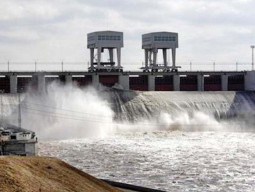
KARACHI:
Fauji Fertilizer Company Energy Limited (FFCEL) has said that the company’s 50-megawatt (MW) wind power project at Jhimpir, Thatta, is not causing any contamination in Keenjhar Lake.
Saying that it will welcome a thorough probe into the matter by any government body, FFCEL Project Director Brig (R) Tariq Izaz told a group of journalists visiting the wind farm on Saturday that such projects were inherently environment-friendly, as the process did not involve any emissions.
“Wind turbines are giant electrical generators, which rotate due to the wind flow and produce clean electricity. They do not require fuel or water to function,” he said.
Earlier, reports had appeared in a section of the media that the wind farm project of the FFCEL had contaminated the lake, which lies at a distance of 4.5 kilometres from the project site. “There is no waste water management or solid waste management required in any wind power project. Therefore, the possibility of contamination is out of the question.”
He said each of the 33 turbines being installed in the wind farm was brought to the site in six parts in the ready-to-install condition. “Even the paint is done at workshops. Only rigging by large cranes and bolting are done on the site, which poses no environmental threat.”
As for civil works, Izaz said, the contractor used globally accepted methods of construction. “Since the ground water level at Jhimpir is approximately 100 metres, there’s no chance that our construction could affect underground water reservoirs. The maximum depth of construction at the FFCEL wind farm is only three metres.”
The Sindh Environment Protection Agency (SEPA) had earlier initiated an inquiry into the affair, as some laboratory tests found a high concentration of urea in the water samples collected from a drain that feeds into Keenjhar Lake.
This was followed by a detailed analysis of water samples taken from the lake by the Pakistan Council of Scientific and Industrial Research (PCSIR), which found no presence of poisonous compounds. However, there was a high concentration of faecal matter which, the PCSIR said, could lead to illness in both humans and animals.
Izaz said the people who first brought up the issue of contamination in the lake could not state specifically how the FFCEL wind farm could be held responsible for it. “One, there is no use of fertiliser in the FFCEL wind farm. Two, if we assume for the sake of argument that there was indeed fertiliser on the site, how did it land in a place that’s many kilometres away? Lastly, fertiliser can’t be called ‘poisonous’ by any stretch of the imagination.”
He said there were lime kilns and agricultural land near the lake, which were more likely to have contributed to the alleged contamination.
He added that factors such as the excessive use of fertiliser or pesticides on the agricultural land and discharge of lime water or cattle/human waste should also be taken into account before blaming the contamination on the clean energy farm of the FFCEL.
Published in The Express Tribune, May 6th, 2012.
COMMENTS (8)
Comments are moderated and generally will be posted if they are on-topic and not abusive.
For more information, please see our Comments FAQ














































@abdussamad is right, you see in the farm one always grows something.Like in the fruit farm one grows fruits,in vegetable farm vegetables,and in poultry farm one grows chicken,so in wind farm FFC must be growing something they are not telling the people.The guy who came up with idea that Wind farm is causing contamination to Keenjhar lake must expecting something under the table from FFC.Bloody fools; it is surely a third rated attempt to discourage the development or as very well said by @Attif Abbas, an attempt to get a Parado from FFC
It would have been better if the link or reference to News and Journalist be provided.Then we can know who is looking for new Prado from FFC.
The allegation against FFCEL is as rediculous as @abdussamad's comment is funny - and that is mega.
Fertiliser helps the wind farm grow!
The people who are spreading this rumor are the same people who destroyed the chances of development of Kalabagh Dam and they are enemies of Pakistan
People just need to be informed and educated more, that's all. @vigilant: So this article makes you think Pakistanis are against development? Your thinking is really limited, any news or analysis etc probably gets you thinking negatively.
Why Pakistanis are against development???